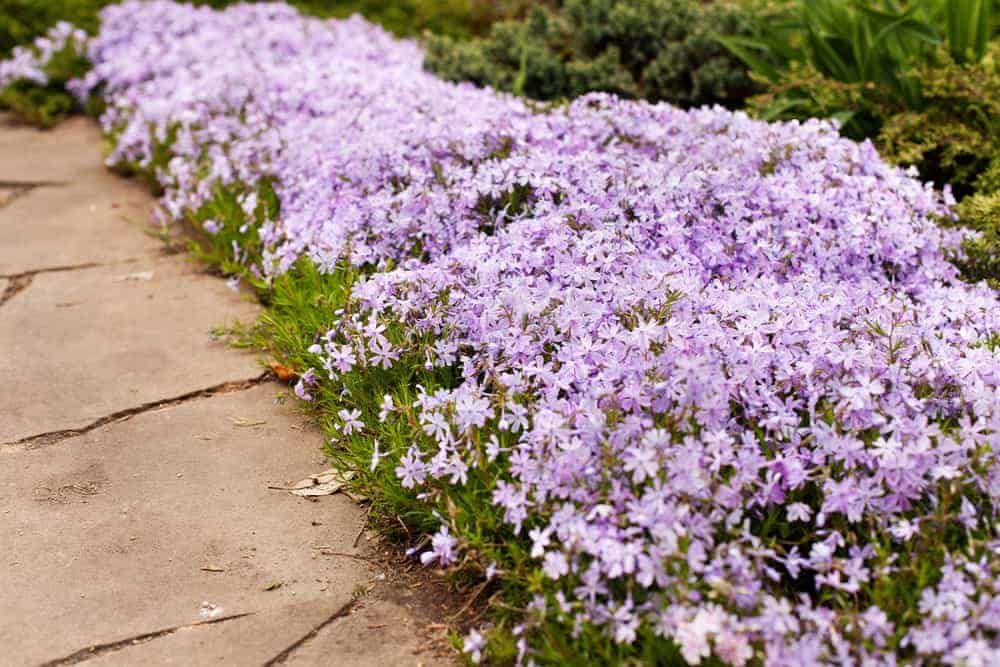Creeping phlox (Phlox subulata) is a popular flowering perennial that blooms in spring and produces masses of delicate flowers in bright colors like purple pink white, red and blue. With its carpet-like mats of needle-shaped leaves and low-growing habit, creeping phlox makes an excellent ground cover. It also looks beautiful spilling over stone walls or containers.
When planting creeping phlox in your garden, it’s important to choose the right companion plants to complement its colors, growth habit and blooming period. The right plant companions will attract pollinators, add color and texture contrast, and fill out bare spots as the phlox finishes flowering. Here are 10 of the best companion plants for creeping phlox:
1. Bulbs
Spring-blooming bulbs like daffodils, hyacinths and crocuses make perfect companions for creeping phlox. These bulbs emerge and flower early, before the phlox is in full bloom. Plant bulbs in small groups among the phlox for a colorful early spring display. Go for bulbs in contrasting colors like purple crocuses or yellow daffodils to make the phlox colors pop.
2. Ornamental Onions
Ornamental onions like chives and alliums are another good choice for pairing with creeping phlox. Let alliums tower above the phlox, providing height and vertical interest. Go for drumstick alliums or purple sensation alliums for gorgeous color contrast. The tightly rounded heads of ornamental onions complement the low, spreading form of creeping phlox.
3. Creeping Thyme
For a low carpet that mirrors the habit of creeping phlox, try planting creeping thyme (Thymus serpyllum). Its tiny leaves and purple flowers form a dense mat that won’t overtake the phlox. Creeping thyme also releases a fresh herbal fragrance when stepped on. Choose variegated creeping thyme for added visual interest.
4. Aubrieta
Also called rock cress, aubrieta is another low-growing perennial that makes an excellent creeping phlox companion. Aubrieta cascades down slopes and walls, mixing effortlessly with creeping phlox. Its purple or blush-pink flowers add fresh color in spring. Let aubrieta trail over the edges of creeping phlox for a beautiful mixed groundcover.
5. Basket-of-Gold
With its bright yellow flowers basket-of-gold (Aurinia saxatilis) creates vibrant contrast next to pastel creeping phlox blooms. Basket-of-gold is also a drought-tolerant spring bloomer that forms a low mat. Plant basket-of-gold alongside purple or blue creeping phlox varieties for a striking color combination.
6. Dianthus
The low-growing perennial Dianthus species and cultivars pair nicely with creeping phlox. Add cushion dianthus or maiden pinks to bloom alongside the phlox in spring. The grassy blue or gray foliage of dianthus also complements the needle-shaped phlox leaves. Choose single blooms in white or pink for a classic combo.
7. Catmint
Catmint (Nepeta) is another long-blooming perennial that makes a great companion for creeping phlox. With its blue or purple flowers and aromatic gray-green foliage, it offers delightful contrast. Plant catmint behind creeping phlox as a mid-level plant. The bushy catmint foliage helps hide spent phlox blooms later in summer.
8. Lamb’s Ear
Lamb’s ear (Stachys byzantina) is grown primarily for its velvety silver foliage that resembles lamb’s ears. Plant lamb’s ear around creeping phlox to echo its foliage shape while adding bushier texture. The soft gray leaves also contrast nicely with the greens and pastels of creeping phlox.
9. sedum
Stonecrop sedum varieties are ideal spreading companions for creeping phlox. Their succulent foliage and clusters of starry flowers come in a variety of colors. Plant low sedums like dragon’s blood stonecrop near creeping phlox for groundcover. Or use taller sedums like Autumn Joy for height contrast.
10. Columbine
Finally, add columbine (Aquilegia) to your creeping phlox garden for its gorgeous spring blooms on tall stems. Its blue, red or white flowers held aloft on wiry stems emerge just after creeping phlox. Plant columbines in drifts among the phlox for vertical color. The lush green foliage also fills in nicely as the phlox finishes flowering. Choose short columbine varieties to keep the balance with creeping phlox.
With so many options for stunning companions, it’s easy to find the perfect plant partners to highlight the beauty of creeping phlox. Use this list to help select companion plants that complement its colors, textures, and growth habit. Plan ahead to enjoy waves of spring blooms in your creeping phlox garden.

Ultimate Companion Plants for Creeping Phlox
FAQ
What plants go well with creeping phlox?
- Spring Bulbs: Creeping Phlox makes a gorgeous underplanting for spring bulbs like tulips and daffodils. …
- Sedums: Sedums and other succulents make great companions for Creeping Phlox in rock gardens or other well-drained spots.
What not to plant with phlox?
- Fennel exhibits allelopathic properties, which can suppress the growth of Garden Phlox by inhibiting seed germination and plant development.
- Its competition for root space and nutrients also makes it a poor neighbor for Garden Phlox.
Does creeping phlox choke out other plants?
-
Dense Growth:Creeping phlox forms a thick mat of foliage, effectively covering the soil surface.
-
Light Deprivation:This dense growth blocks sunlight from reaching the ground, which is essential for the growth of many weeds and other plants.
-
Outcompeting Weeds:By creating a dense, shaded environment, creeping phlox outcompetes and suppresses weeds, making it a good choice for groundcover in areas where weed control is a concern.
-
Not Invasive:While creeping phlox can be aggressive in certain situations, it is generally not considered an invasive species.
-
Weed Suppression:Creeping phlox can effectively prevent weeds by crowding them out, reducing the need for frequent weeding.
What are the downsides of creeping phlox?
Creeping phlox may present with spotty leaves, soft stems, and mushy roots. This typically happens when creeping phlox is planted in poorly draining and excessively moist soil that does not have adequate air circulation. The result is mold and root rot.
